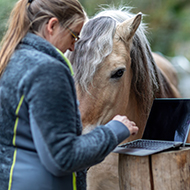Epilepsy study sheds light on survival chances

Researchers found affected dogs with no cluster seizures lived significantly longer.
Idiopathic epilepsy is more prevalent in Italian Spinoni that the general canine population, according to research by the Animal Health Trust (AHT). Their study, believed to be the first of its kind, may help to improve survival in these dogs.
Over 5 per cent of the Italian Spinoni involved in the research were found to have the condition. In the UK's general canine population, prevalence is estimated to be just 0.6 per cent, though it can be as high as 18.3 per cent, depending on country and breed.
In the AHT's survey of 1,192 Spinone owners, 63 dogs had idiopathic epilepsy (IE). The owners of these dogs were then invited to complete a further questionnaire and make available their dog's medical records.
Looking at the survival times of the affected dogs, researchers found those with no cluster seizures lived significantly longer. Survival was also substantially longer in Italian Spinoni whose treatment with anti-epileptic medication had started after the second seizure, rather than after the third.
Lead author Luisa De Risio explained: "From this sample we were able to conclude that idiopathic epilepsy in this breed often has a severe presentation but starting treatment with antiepileptic medication after the second seizure, and aggressive treatment of cluster seizures, may improve the survival of these dogs."
IE is the most common, chronic neurological disorder seen in dogs, but appears more commonly in some breeds than others, including Irish wolfhounds, border collies and of course, Italian Spinoni. It is a very complex and difficult disease to treat in dogs, just as it is in humans.
Work is also underway at AHT to identify the genetic mutations responsible for the disease so a genetic test could be developed. Due to the complexity of the genetics, however, such a test is most likely "many years away", Dr De Risio says.
In the meantime, she adds: "We hope these findings will help to increase veterinary knowledge and understanding of this horrible disease and give Italian Spinoni, and other affected breeds, the best chance of fighting IE."



 With Strangles Awareness Week just around the corner (5-11 May), vets are being encouraged to share a survey about the disease with their horse-owning clients.
With Strangles Awareness Week just around the corner (5-11 May), vets are being encouraged to share a survey about the disease with their horse-owning clients.